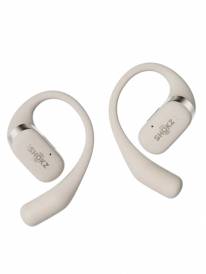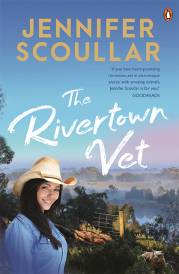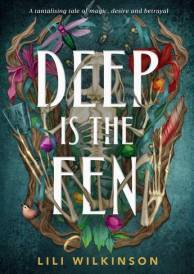Geraldine Georgeou Exam Food Preparation Interview

Geraldine Georgeou Exam Food Preparation Interview
As Australian teens prepare for the most important exams of their lives, a new survey has revealed that students' snacking behaviours may be compromising study routines and resulting in significant time wastage.
The survey, commissioned by Meat & Livestock Australia, revealed that the average student snacks as much as three times on a typical study day – with students favouring treats like chips, lollies or chocolate, over more nutritious food choices. Almost three quarters (73%) of students say they snack more when studying for exams, with as many as 30% thinking about food or snacking most or all of the time during a study session.
Accredited Practicing Dietitian Geraldine Georgeou, together with Meat & Livestock Australia, has developed a specially formulated 'Study Diet" and 'Exam Tips" to ensure parents can play a more proactive role in their teens' exam prep.
Geraldine says: 'Poor food choices aren't providing the brain fuel teens need, so study time is wasted scouring the pantry shelves and raiding the fridge in the constant search for more". The Study Diet provides healthy meals and snack ideas packed with nutrient-rich foods that are recommended in the Dietary Guidelines. Choosing these foods such as beef and lamb 3 to 4 times a week keeps teens' iron and zinc levels in check and keeps them feeling fuller for longer, focused and full of energy so they can study efficiently and perform well at exam time."
'Including 3 to 4 serves of beef and lamb a week provides iron to support brain function and zinc for a healthy immune system. Survey results reveal that only one in ten students are snacking on nutrient-rich protein foods such as beef or lamb leftovers. Red meat is especially important at this time as low iron can contribute to tiredness and fatigue which may make it difficult to study effectively," she says.
The Study Diet includes meal plans tailored to suit the nutrition needs of teenage boys and girls and is delicious at the same time. With detailed food choices for breakfast, lunch, dinner and numerous healthy snacking options, the Study Diet shows how eating right can be the first step to aid in study success.
For more tips, advice and nutritious recipe ideas, visit www.themainmeal.com.au/studydiet
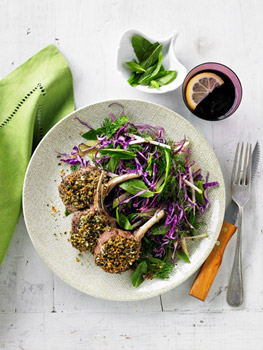 Herb Crusted Lamb Cutlets with Red Cabbage and Green Apple Slaw
Herb Crusted Lamb Cutlets with Red Cabbage and Green Apple Slaw
SERVES: 4
PREPARATION TIME: 20 minutes + resting
COOKING TIME: 15 minutes
Ingredients
12 lamb cutlets, Frenched, fat trimmed
2 tbsp roughly chopped flat-leaf parsley
2 tbsp roughly chopped oregano
20g (1/4 cup) finely grated parmesan
35g (1/3 cup) packaged breadcrumbs
2 tbsp lemon juice
2 tbsp extra virgin olive oil
2 cups shredded red cabbage
2 small green apples, cored, thinly sliced
1/3 cup mint leaves
1/3 cup dill sprigs
Method
To make the herb crust, place the herbs parmesan and breadcrumbs in a small bowl, and toss to combine
Preheat a griller to high. Scatter the herb crust evenly over the lamb cutlets and place on a large oven tray. Grill on the middle shelf for 15 minutes or until cooked to your liking. Rest, covered loosely with foil, for 5 minutes before serving
Meanwhile, to make the salad, whisk juice, honey and oil in a large bowl until combined. Add the cabbage, apples and herbs and toss to combine
To serve, divide the salad among four plates and top with cutlets
Tips:
You can substitute cabbage with green cabbage, cos lettuce or a fresh coleslaw mix from your local supermarket
This crust is great with other cuts of your favourite red meat
Get your butcher to French and trim your cutlets of any fat
Optional additional sides:
Smashed Pumpkin
Ingredients
500g butternut pumpkin, seeded, peeled, roughly chopped
2 tbs olive oil
½ tsp mixed spice
Method
Place the pumpkin, oil and spice in a medium roasting pan and toss to coat. Roast on the top shelf of an oven, tossing occasionally, for 20 minutes or until tender and slightly caramelised. Using a large fork, roughly smash the pumpkin
Meanwhile, cook the snake beans in a saucepan of boiling water for 3 minutes or until cooked but still crunchy, then drain
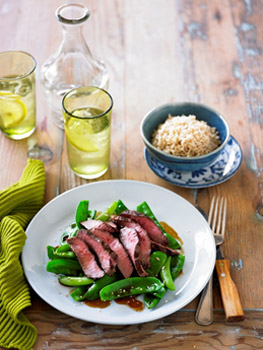 Beef Rump Steaks with Crunchy Greens and Brown Rice
Beef Rump Steaks with Crunchy Greens and Brown Rice SERVES: 4
PREPARATION: 15 minutes
COOKING: 25 minutes
Ingredients
4 x 200g beef rump steaks, fat trimmed
200g (1 cup) brown rice
300g, sugar snap peas, trimmed
300g snow peas, trimmed
2cm piece ginger, finely grated
1 tbsp soy sauce, salt reduced
2 tsp toasted sesame seeds
½ tsp sesame oil
Method
Cook the brown rice in a saucepan of boiling water for 25 minutes or until rice is cooked or alternatively cook according to packet instructions
Preheat a lightly greased char grill pan or barbecue to high. Meanwhile, cook the rump 2½ minutes each side or until cooked to your liking. Rest, covered loosely with foil, for 5 minutes before serving
To serve, divide the vegetables and rice among four plates and top with the beef rump steaks
Tips:
If you like, substitute the brown rice with your favourite grain, such as couscous, basmati rice or barley
Mix and match your choice of vegetable according to seasonality and availability
Interview with Geraldine Georgeou
Question: Can you talk us through why the Study Diets provided at www.themainmeal.com.au/studydiet work best for students during exam time?
Geraldine Georgeou: The study diet provides students with a high protein, lower in processed carbs and sugar diet including essential nutrients to fuel a teenagers body and mind. The plan is packed with iron to produce energy for brain function and zinc to help with focus.
Question: What types of foods feature in these diets that are especially important for those studying?
Geraldine Georgeou: The eating plan combines the best fuel foods including wholegrain breads and cereals, lean red meat, dairy, fish, legumes and fruit and vegetables which help with better concentration to help with studying and maintaining energy.
Question: And, why is it important to include beef and lamb 3 to 4 times a week?
Geraldine Georgeou: There has been a focus in the plan on lean red meat, we've included recipes in the plan that include beef and lamb 3 to 4 times a week which helps prevent low levels of iron which is particularly important for teenage girls because they're already at risk. The meat in the plan will help teenagers with concentration, memory, learning abilities and provide all the essential nutrients which have better protein, zinc and omega-3s.
Question: Why is snacking causing our students to loose valuable time?
Geraldine Georgeou: Teenagers don't think about what they're eating and this study showed that 73% of students are snacking all day and actually not eating meals. And, 30% are thinking about food or snacking rather than studying. Students favour chips, lollies or chocolate which could be for comfort and they don't think choosing something that is better for you is just as quick and easy as well as being much more long lasting for energy compared to other foods they may be grabbing.
Question: Why is it important to have a diet high in protein and low GI?
Geraldine Georgeou: Low GI is a word we are all becoming familiar with. Low means slow and glycaemic means glucose in the blood so if we have slow release carbohydrates or slow release fuel that releases glucose in the blood stream much slower that means we'll get less peaks and drops in energy.
The foods teenagers are choosing are high GI which means they get a quick release into the blood stream and short lasting energy similar to a sparkler, it lasts 30 seconds and is an up and down fuel rather than a steady release fuel.
Question: If a snack is needed and time allows, what should students be snacking on instead of chips, lollies or chocolate?
Geraldine Georgeou: The low GI snack ideas I'm suggesting are foods that will keep that energy level ticking over and ensure you're not sending yourself to sleep or blurred and confused. I suggest: wholegrain crackers with cheese, nuts and dried fruit or low fat yoghurt because those choices are much more long lasting in terms of energy between breakfast, lunch and dinner. You'll see at www.themainmeal.com.au/studydiet that the snacks are young-people friendly such as ice-cream, milo and things like that to coincide with the other items they are having during that day as per the plan to provide the lower GI and protein balanced choice.
Question: What vital nutrients and vitamins are we missing from our diets, every day?
Geraldine Georgeou: The main two food nutrients or groups that I find missing in many teenagers is iron and zinc. We've included foods in this study guide that provide adequate sources of iron and zinc. Teenagers often have a good meal, like dinner, prepared by Mum or Dad, at home but we forget to disperse these important nutrients throughout breakfast and lunch. Every meal needs to have a source of protein for example the breakfast meal contains an egg on toast or porridge with fruit and low fat milk, which includes nutrients like calcium. At lunchtime we include a lean protein with low GI form of salad or vegetables. The low GI carbohydrate could be wholegrain bread or basmati rice, or left over baked beans, tuna, ham or even left-over dinner such as Spaghetti Bologanise. The protein aspect is important and instead of just a Vegemite sandwich, have a Vegemite and cheese sandwich.
The snacks, I mentioned before, are dispersed throughout the day and are used in conjunction with a good healthy dinner whether that is a beef stirfry, beef casserole or a fish meal. These meals provide the nutrients that are commonly missing.
Question: Is food preparation the most important resource for long lasting energy and concentration for those studying? How can students prepare their food?
Geraldine Georgeou: The www.themainmeal.com.au/studydiet allow teenagers to pick and choose what they like the idea of and ask their parents if they can chip in and help. The diet contains pretty common meal ideas and they're not hard to make, they're quite simple and probably cooked within the home, already. It's about reminding teenagers to eat regular meals and snacks. It's important for the teenagers to look at the next meal and prepare too, whether they pre-boil their eggs on the morning of an exam so they only have to mash the egg and put on a piece of toast with salt and pepper.
Question: During the study period should students be increasing their meal size or the amount of meals they're consuming?
Geraldine Georgeou: I don't think it's about increasing the meal size; although teenage boys don't always meet their requirements because they can be more active and males have a higher calorie requirement. It is important to eat as that's the concern and a lot of students dismiss meals and before they know it they've rushed off to the library and they've got chocolate because they think that's all they need.
In my day, I'd go to the State library and the one reason I went there was because they had a café and I'd make time to go to the café for lunch. It's about ensuring you get your meal times in because it gives you a mental head break to enable you to return to study and provide a good structure for the day.
It's important to keep active as well, whether you walk your dog, or play ball with mates in between study time. You may need to draw up a timetable to include study and exercise periods.
Question: Can you tell us about Designer Diets?
Geraldine Georgeou: I've been a dietician for twenty years now and I'm a clinical dietician and Designer Diets came about because people need to know what is the right food, for them. It's about designing a diet for life, it's not about an on-off approach. Designer Diets means I look at your health, your life cycle, your situation and may also run a blood test to check where you are at.
Think of it this way; you know what car you have and how the car runs and what fuel to use you can drive the car better – it's about designing an eating plan that is right for you.
Interview by Brooke Hunter
MORE


